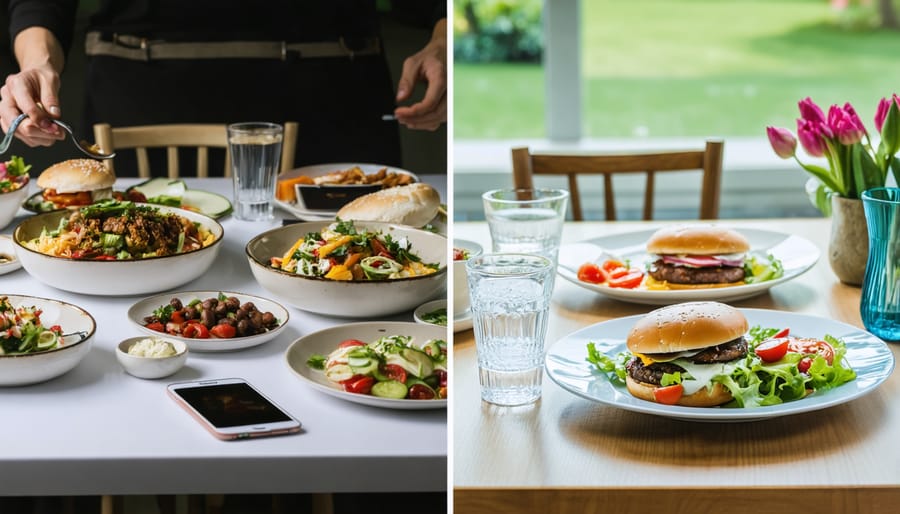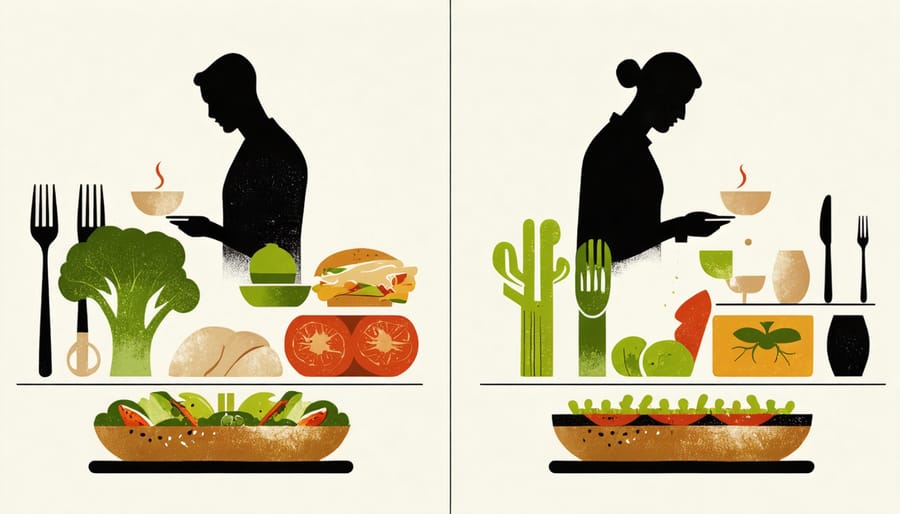
Take a single deep breath and place your fork down between each bite to transform your relationship with food. Notice the colors, textures, and aromas on your plate before taking that first bite. This simple practice can revolutionize your eating habits and boost your overall wellness.
Think of mindful eating as a gentle conversation with your body – one where you’re finally slowing down enough to listen. Gone are the days of rushed lunches at your desk or mindless snacking during Netflix binges. Instead, you’re creating a peaceful ritual that honors both your food and your body’s natural wisdom.
This isn’t about perfect practice or strict rules; it’s about bringing awareness back to one of life’s most fundamental pleasures. Whether you’re enjoying your morning coffee or sitting down to a family dinner, these moments of mindful connection offer a beautiful opportunity to nourish both body and soul.
Why Traditional Dieting Often Fails (And How Mindful Eating Differs)
Have you ever found yourself cycling through diet after diet, only to end up back where you started? You’re not alone. I remember my own experience with traditional dieting – counting every calorie, avoiding entire food groups, and feeling guilty about every “cheat” meal. It was exhausting, and like many women, I discovered that this approach simply wasn’t sustainable.
Traditional dieting often fails because it focuses solely on external rules while ignoring our body’s internal wisdom. These diets typically revolve around restriction, creating an all-or-nothing mindset that can lead to emotional eating, binge episodes, and a complicated relationship with food. They also tend to overlook important factors like emotional well-being, cultural connections to food, and our natural hunger and fullness cues.
This is where mindful eating differs fundamentally. Rather than imposing strict rules, mindful eating encourages us to tune into our body’s natural signals and make conscious choices about food. It’s about being present during meals, understanding our hunger and fullness cues, and recognizing emotional triggers that influence our eating habits.
Think of mindful eating as building a friendship with your body rather than trying to control it. Instead of following external guidelines about when and what to eat, you learn to trust your body’s wisdom. This approach helps create a more peaceful relationship with food, reducing stress and anxiety around eating.
The best part? Mindful eating is inclusive and adaptable to your unique lifestyle. There’s no “failing” because it’s not about perfection – it’s about progress and awareness. As you’ll discover in the exercises that follow, this gentle approach can lead to lasting, positive changes in your eating habits.

The Science Behind Mindful Eating
Have you ever wondered why eating mindfully feels so different from rushing through your meals? Science has some fascinating answers! Research from Harvard Medical School shows that when we eat mindfully, our bodies actually process food more efficiently and we’re more likely to notice our natural fullness cues.
I remember when I first learned about the study that found mindful eaters typically consume 300 fewer calories per meal without even trying. It’s not about restriction – it’s about being present and truly enjoying every bite. When we eat mindfully, our digestive system gets a head start because we’re activating what scientists call the “rest and digest” response.
A particularly interesting study from the University of California showed that people who practiced mindful eating reported feeling more satisfied with smaller portions and experienced fewer cravings throughout the day. It turns out that when we slow down and really experience our food, our brain has time to register the nutrients and signal satisfaction appropriately.
The research also reveals that mindful eating helps reduce stress-related eating patterns. When we’re present with our meals, our cortisol levels (that’s our stress hormone) tend to decrease, which not only helps with digestion but also supports better food choices overall. It’s amazing how something as simple as paying attention to our eating experience can have such profound effects on our relationship with food!
Your 10-Minute Mindful Eating Exercise
Setting Up Your Space
Creating a peaceful environment for your mindful eating practice is essential for success. Choose a quiet spot away from distractions like TV, phones, or computers. I love transforming my dining table into a mindful space by clearing away clutter and adding a simple centerpiece – even just a small vase of flowers can make a difference.
Set your table thoughtfully with a clean placemat and your favorite dishes. Natural lighting works wonders, but if you’re eating in the evening, soft lighting can create a calm atmosphere. Consider using a cloth napkin instead of paper – these small touches help signal to your brain that this is a special, intentional moment.
Remember, this doesn’t need to be Instagram-perfect. The goal is creating a space where you can focus on your meal and your connection with food.

The Five Senses Experience
Let’s explore how each of your senses plays a vital role in transforming a simple meal into a mindful experience. Start by selecting a small portion of food – perhaps a single strawberry or a piece of dark chocolate – and find a quiet space where you can focus without distractions.
Begin with sight: Take a moment to really look at your food. Notice its color, shape, and how light reflects off its surface. Is there variation in the hues? Any unique patterns or textures that catch your eye?
Next, explore touch: Hold the food item gently in your fingers. Is it smooth or rough? Warm or cool? Pay attention to its weight and texture against your skin. These sensations often go unnoticed during regular meals.
Now, bring the food closer and notice its aroma. Close your eyes if it helps you focus on the scent. Does the smell trigger any memories? Can you identify different notes in the fragrance?
Before taking a bite, listen. Some foods make subtle sounds even before we eat them – like the gentle snap of a crisp apple or the rustle of leafy greens. Then, as you take that first bite, notice any sounds that emerge.
Finally, taste – but slowly. Let the food rest on your tongue for a moment before chewing. Notice how the flavors evolve, how the texture changes, and how your body responds. Can you detect subtle flavors you might usually miss?
Remember, this isn’t about judging the experience – it’s about being present and aware of each sensation as it unfolds.

Mindful Chewing and Breathing
Have you ever noticed how quickly you finish a meal without really tasting it? Let’s change that. Take a moment before each bite to observe your food’s colors, textures, and aromas. As you take a bite, chew slowly and deliberately – aim for 20-30 chews per mouthful. I love pairing this with what I call the “five-breath practice”: take five conscious breaths between bites, letting your fork rest on the plate.
Try this simple technique: take a bite of food, then close your eyes while you chew. Notice how the flavors evolve and intensify. Focus on your breathing – inhale through your nose, exhale through your mouth. This combination of mindful chewing and breathing not only enhances your dining experience but also helps your digestion and naturally slows down your eating pace.
Incorporating Mindful Eating Into Daily Life
Making mindful eating a regular part of your daily routine doesn’t have to feel overwhelming. As someone who once rushed through meals at my desk, I’ve discovered that small, consistent changes can lead to lasting habits. Let’s explore some practical ways to create more mindful moments during meals throughout your day.
Start by designating one meal per day as your mindful eating practice. Many find breakfast ideal since mornings tend to be quieter. Set your phone aside, find a comfortable spot, and take just five minutes to really experience your food. As this becomes natural, gradually extend the practice to other meals.
Create environmental cues that remind you to slow down. Something as simple as using your non-dominant hand to hold your utensils can help break automatic eating patterns. Place a small plant or candle on your dining table as a visual reminder to stay present with your meal.
When life gets busy (and we all know it does!), practice “micro-moments” of mindfulness. Take three conscious breaths before starting your meal, pause between bites, or simply notice the colors on your plate. These small actions can anchor you to the present moment, even during rushed lunches.
Make it social by involving your family or friends. Share your mindful eating journey, discuss the flavors you notice, and create a supportive atmosphere around meals. Children especially love participating in “food detective” games where they describe textures and tastes.
Remember, consistency matters more than perfection. If you find yourself rushing through a meal, simply acknowledge it without judgment and return to mindful eating at your next opportunity. With time, these practices will become second nature, transforming your relationship with food into one of greater awareness and joy.
As we wrap up our mindful eating journey together, remember that this practice isn’t about perfection – it’s about progress and building a more conscious relationship with food. By incorporating these simple exercises into your daily routine, you’re taking meaningful steps toward a more balanced and enjoyable approach to eating.
Start small – perhaps with just one mindful meal a day – and gradually build from there. Notice how your body feels, how your relationship with food shifts, and most importantly, how you become more attuned to your hunger and fullness cues. Many women in our community have shared how these practices have transformed not just their eating habits, but their overall well-being too.
I remember when I first started practicing mindful eating; it felt awkward and time-consuming. But now, it’s become second nature, and I can’t imagine eating any other way. The beauty of mindful eating is that it’s entirely personal – you get to define what works best for you.
Remember, this journey is yours to own. Whether you’re dealing with a busy schedule, family responsibilities, or other life demands, there’s always room to incorporate moments of mindfulness into your meals. Be patient with yourself, celebrate small victories, and know that every mindful bite is a step toward a healthier, more balanced relationship with food.
Ready to begin? Your next meal is the perfect opportunity to start your mindful eating practice. Take that first conscious bite, and let the journey unfold naturally.



